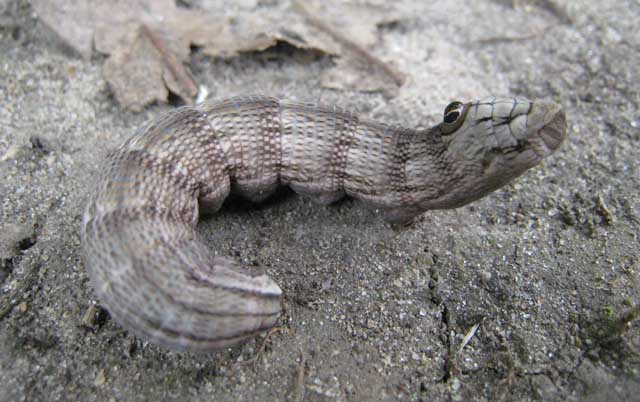Sphinginae subfamily
Sphingini tribe:
 |
Ceratomia amyntor WO, Elm Sphinx, Four-horned Sphinx:
Elm (Ulmus), birch (Betula), basswood (Tilia), cherry (Prunus).
Both green and brown forms. Four horns near head are diagnostic.
|
 |
Ceratomia catalpae WO, Catalpa Sphinx:
Young caterpillars feed gregariously on Catalpa species (Catalpa bignoniodes and C. speciosa) in the
Bignoniaceae family, skeletonizing the foliage. Larvae are mostly white in early instars.
|
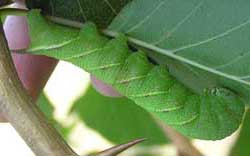 |
Ceratomia hageni WO, Hagen's Sphinx, Osage Orange Sphinx:
Larvae feed on osage orange (Maclura pomifera), and they have a granulous appearance with variable amounts of purple
along the oblique white stripes.
|
 |
Ceratomia undulosa WO, Waved Sphinx:
Fraxinus, Ligustrum, Quercus, Crataegus, Chionanthus virginicus.
In the fifth instar, the spiracular ovals are decidedly red and the anal horn is off-white to pinkish laterally.
|
 |
Dolba hyloeus WO, Pawpaw Sphinx:
Pawpaw (Asimina triloba), littleleaf sweetfern
(Myrica aspleniifolia), possum haw (Ilex decidua),
inkberry (Ilex glabra),Tall Gallberry Holly (Ilex coriacea).
|
 |
Lapara bombycoides WO, Northern Pine Sphinx:
This caterpillar is also without the anal horn and feeds on pines.
The long stripes and reddish brown afford great camouflage. unlikely possibility
|
 |
Lintneria eremitus WO, Hermit Sphinx:
Note triangular bump on the thorax. Larval hosts are various species of beebalm (Monarda), mints (Mentha), bugleweed (Lycopis),
and sage (Salvia).
|
 |
Manduca quinquemaculatus WO, Five-spotted Hawkmoth:
Tomato Hornworms: black horn at the end of the abdomen. Larvae feed on potato, tobacco, tomato, and other plants in the nightshade family (Solanaceae).
|
 |
Manduca sexta BAMONA/JP, Carolina Sphinx:
Tobacco Hornworms, equipped with red-tipped horn at end of
abdomen; true gluttons, feed on tobacco and tomato, occasionally potato, pepper crops, plants in nightshade family (Solanaceae).
|
 |
Paratrea plebeja WO, Plebeian Sphinx:
Common trumpetcreeper (Campsis radicans),
Florida yellow-trumpet (Tecoma stans), lilac (Syringa species),
passionflower (Passiflora species). The anal horn is blue, preceded by a yellow dash. unlikely possibility
|
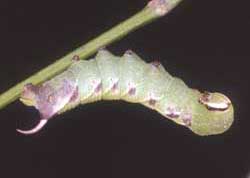
| Sphinx canadensis WO, Canadian Sphinx:
This species is not common at lights, and is not often reported anywhere.
Larval host may be exclusively black ash (Fraxinus nigra).
Variable appearance but always with granulous (darker protrusions) on pinkish horn.
|
 |
Sphinx chersis WO, Northern Ash Sphinx, Great Ash Sphinx:
Pale bluish green. Head has pair of yellow lateral bands meeting at apex. Oblique, lateral stripes: pale, bordered anteriorly with darker green.
Ash, lilac, privet, cherry, quaking aspen.
|
 |
Sphinx drupiferarum WO, Wild Cherry Sphinx:
Larvae hide by day, feed primarily on cherry, plum, apple
at night. Amelanchier nantuckensis
in Massachusetts; Michigan on Prunus serotina. Note purple oblique lines.
|
 |
Sphinx gordius WO, Apple Sphinx:
Apple (Malus), sweetfern (Myrica), Carolina rose (Rosa carolina), blueberry and huckleberry
(Vaccinium), white spruce (Picea glauca), American larch (Larix laricina), alder (Alnus).
|
 |
Sphinx kalmiae WO, Laurel Sphinx:
In the final instar, the black on the head, lateral lines, horn and on abdominal
legs is diagnostic.Larvae feed primarily on lilac and fringe.
|
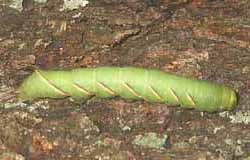 |
Sphinx luscitiosa WO, Canadian Sphinx, Clemen's Sphinx:
Willow (Salix), poplar (Populus), birch (Betula), apple (Malus), ash (Fraxinus), waxmyrtle (Morella), northern bayberry.
|
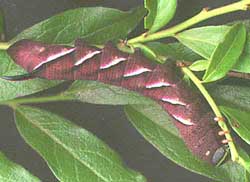 |
Sphinx poecila WO, Poecila Sphinx:
If you have blueberries in the woods, then you probably have the Poecila Sphinx.
unlikely possibility
|
Smerinthini Tribe:
 |
Amorpha juglandis WO, Walnut Sphinx:
Walnut and butternut (Juglans), hickory (Carya), alder (Alnus), beech (Fagus),
hazelnut (Corylus), hop-hornbeam (Ostrya). |
 |
Pachysphinx modesta WO,
Modest Sphinx, Poplar Sphinx:
Larvae feed on poplars and cottonwood. Note very short anal horn.
|
 |
Paonias excaecata WO, Blinded Sphinx:
Larvae accept willows, birches, and cherries.
I have also found them in the wild on oak in eastern Canada.
|
 |
Paonias myops WO, Small-eyed Sphinx:
Wild cherry species are the favorites as larval foodplants, but eggs
will also be deposited on birches and other forest trees. There are varying degrees in the amount of red markings along the sides.
|
 |
Smerinthus cerisyi WO, Cerisy's Sphinx;
Pale green, granular skin, pale lateral diagonal lines, faint red
spiracular circles, pale longitudinal lines running from
head to more pronounced anal diagonal line. Green head bounded dorsally with pale yellow inverted V.
|
 |
Smerinthus jamaicensis WO, Twin-spotted Sphinx:
Birches and cherries, expecially fond of poplars and willows. Red markings on sides
vary greatly from specimen to specimen.
|
Macroglossinae subfamily
Dilophonotini Tribe:
See Hemaris comparison to help distinguish
the next three species.
 |
Hemaris diffinis BAMONA, Snowberry Clearwing:
Snowberry (Symphoricarpos), honeysuckle (Lonicera), Coralberry, viburnums, Blue Dogbane
(Apocynum), dwarf bush honeysuckle (Diervilla lonicera).
Horn black, yellow base.
|
 |
Hemaris gracilis WO, Slender Clearwing, Graceful Clearwing:
Blueberries, low bush blueberry (Vaccinium vacillans), laurel (Kalmia), in heath family (Ericaceae).
|
 |
Hemaris thysbe BAMONA, Hummingbird Clearwing:
Orangey-pink prepupal form. Lateral line runs from S1 to blue horn. Viburnum and related plants.
generally more eastern species
|
Philampelini Tribe:
 |
Eumorpha achemon WO, Achemon Sphinx:
Grape (Vitis), Virginia Creeper (Parthenocissus quinquefolia), vines, ivies (Ampelopsis).
Larvae occur in both light (green) form and darker (tan/brown) form. Note six "segmented" oblique lines.
|
 |
Eumorpha pandorus WO/BAMONA, Pandorus Sphinx:
If you have Grape or Virginia Creeper nearby, then you might encounter
this species. Note the five large white ovals. There are orangey-brown and green
forms also.
|
Macroglossini Tribe:
 |
Amphion floridensis WO, Nessus Sphinix:
Virginia creeper, Grape (Vitis), ampelopsis (Ampelopsis), and cayenne pepper (Capsicum).
Larvae are green until the final instar.
|
 |
Darapsa choerilus WO, Azalea Sphinx:
Azalea, Viburnum; progress rapidly. Larva (left) on Viburnum cassinoides, readyin for
pupation. Color change from green to light burgundy-brown indicates pupation imminent. |
 |
Darapsa myron WO, Virginia Creeper Sphinx, Grapevine Sphinx:
If you have foodplants indicated in common names, you probably have myron. Virginia creeper (Parthenocissus quinquefolia),
Grape (Vitis), Ampelopsis, Viburnum.
|
 |
Darapsa versicolor WO, Hydrangea Sphinx:
Smooth hydrangea (Hydrangea arborescens), buttonbush (Cephalanthus occidentalis), and waterwillow
(Decodon verticillatus). Note small head which can be retracted into the thorax.
|
 |
Deidamia inscriptum WO, Lettered Sphinx:
Grape (Vitis), ampelopsis (Ampelopsis), Virginia creeper (Parthenocissus).
The alternating yellow and greyish-green rings across the back
distinguish this larva.
|
 |
Hyles gallii BAMONA, Bedstraw Hawk Moth, Gallium Sphinx:
Larvae come in black and in brown forms and often feed on
Epilobium (fireweed). unlikely possibility
|
 |
Hyles lineata BAMONA, White-lined Sphinx:
Highly varied. Willow weed (Epilobium), four o'clock (Mirabilis),
apple (Malus), evening primrose (Oenothera), elm
(Ulmus), grape (Vitis), tomato (Lycopersicon),
purslane (Portulaca), Fuschia.
Red/black swellings split by dorso-lateral lines. |
 |
Sphecodina abbottii EB, Abbott's Sphinx:
Larvae feed at night on grape (Vitis), ampelopsis
(Ampelopsis), hide on bark by day. Virginia creeper. Also dark form
without green patches. Note "raised eye", replacing anal horn.
|
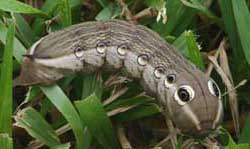 |
Xylophanes tersa
WO(adult moth), Tersa Sphinx: Borreria, Catalpa and Manettia spp.,
Smooth buttonplant (Spermacoce glabra), starclusters
(Pentas species). Joe-pie weed, Hamelia patens, Hedoydis nigricans. Green form may be more common.
breeding populations in southern Illinois
|
|
|
